A comprehensive look at STEM degrees, talent migration, and skills in demand
This edition of the Innovation Index is brought to you by: the Illinois Science and Technology Coalition, in partnership with: LinkedIn.
Download the full 2016 Talent Index.
Overview
Sustained investments are being made nationwide to increase the number of science, technology, engineering, and math (STEM) graduates from U.S. universities. These efforts are an acknowledgment of the important role STEM fields are likely to play in the 21st-century global economy. Indeed, the U.S. Bureau of Labor Statistics forecasts that employment in STEM will increase 8.9 percent from 2014 to 2024, handily outpacing non-STEM employment’s rise of 5.7 percent over the same period. 1
STEM fields are a key driver of research, innovation, and entrepreneurship. They also deliver a higher quality of living: in 2013, STEM occupations paid an average of $79,640 compared with $46,440 for all occupations 2 So states that can produce a sufficient supply of STEM graduates to fill occupations in thriving sectors stand to benefit significantly.
This issue of the Illinois Innovation Index is devoted to talent, the fourth year in a row we have assessed the state’s STEM performance. As with past issues, we examine both Illinois’ supply (as measured by total STEM graduates and talent migration) and demand (job openings overall and skills in-demand) in STEM and STEM-related fields. In addition to traditional data sets, this year we are partnering with LinkedIn, which generously provided valuable data on Illinois’ skills gaps and talent migration for our analysis.
Key findings: supply
- Illinois extended its lead in STEM graduates compared with the country as a whole. In 2015, 29.1 percent of the state’s graduates earned STEM
degrees compared with 27.0 percent nationally. - In 2015, computer science degrees reached their highest level in Illinois in more than a decade, making the state the second-largest producer nationally
- Illinois is also a national leader in the production of health degrees and STEM master’s degrees and is the fourth-leading producer of MBAs in the United States.
- The immigrant workforce in Illinois is vital to the state’s economy. Illinois outpaces the nation in share of immigrants in the workforce, immigrants’ share of STEM degrees, and immigrant entrepreneurship.
Key findings: demand
- The percentage of STEM jobs in Illinois slightly trails the national average, while STEM-related jobs (typically in healthcare) exceed the national average. However, projections show that STEM jobs will grow at a faster rate than the national average over the coming decade.
- New LinkedIn data show several computer programming languages, user interface design, and statistical analysis and data mining are among the most hirable skills in Illinois.
- LinkedIn’s upcoming Skills Gap Index highlights areas of strength and opportunity in Chicago. Categories rich with talent include several business and management skills, while opportunities exist for those with programming and other computer-related skills.
Part I: Supply of STEM talent
As in previous issues of the Index, our analysis of supply primarily focuses on the number of students attaining bachelor’s, master’s, or doctoral degrees in STEM fields 3 However, this issue also highlights LinkedIn data on talent migration in Illinois, including the skills gained and lost due to migration, and the important role of immigration.
STEM degree production
According to data from Integrated Postsecondary Education Data System (IPEDS), 4 29.1 percent of all degrees earned in Illinois (approximately 35,800 degrees) were in STEM fields in 2015, a greater share than the national average of 27 percent. It marked the third straight year that Illinois had exceeded the national average: in 2012, Illinois’ growth trajectory accelerated, surpassing the national average in 2013. Since then, the margin between Illinois and the nation’s STEM graduates has steadily increased.
The continued increase in the number of Illinois’ STEM degrees in 2015 is due to growth in several subject areas, including computer science and engineering, which each increased more than 10 percent from 2014 to 2015. As was the case for most of the past decade, Illinois’ proportion of non-health STEM degrees remained about 1 percent lower than the national average in 2015.
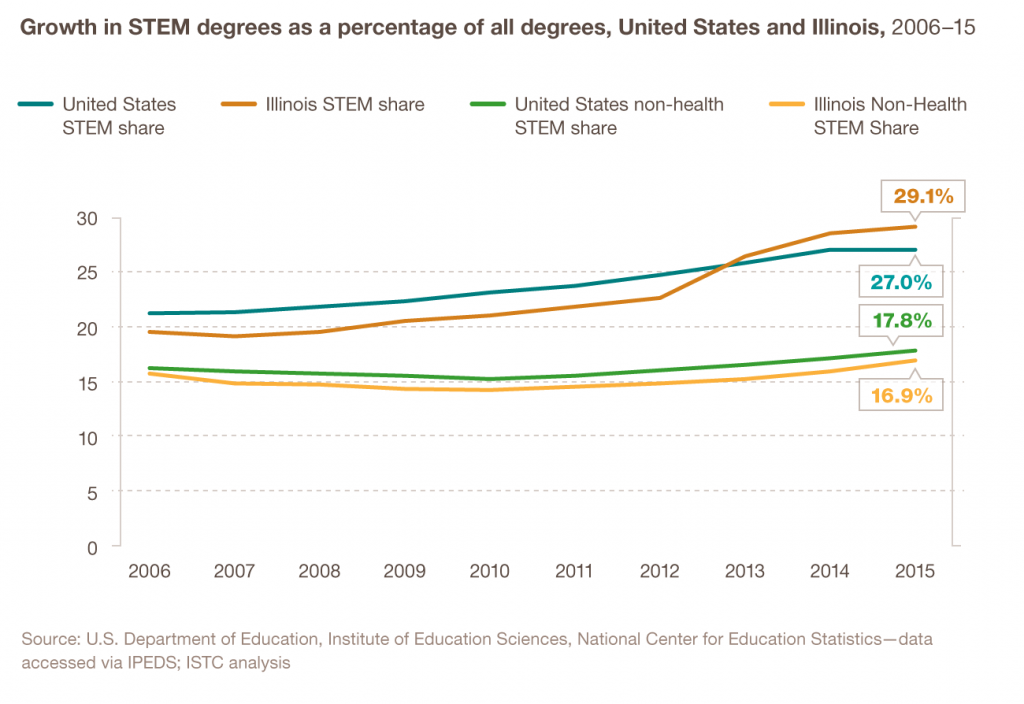
An evaluation of STEM attainment by type of degree reveals that Illinois continues to produce a greater percentage of advanced degrees than the national average. More than 35 percent of STEM graduates earned master’s or doctoral degrees compared with a national average of 31.5 percent. Master’s degrees made up the bulk of the post-graduate degrees, with 29.1 percent. Illinois universities also employ nearly 2,300 postdocs in STEM, the seventh-most in the nation 5 This concentration of advanced degrees and postdocs gives Illinois unique access to higher-level talent.
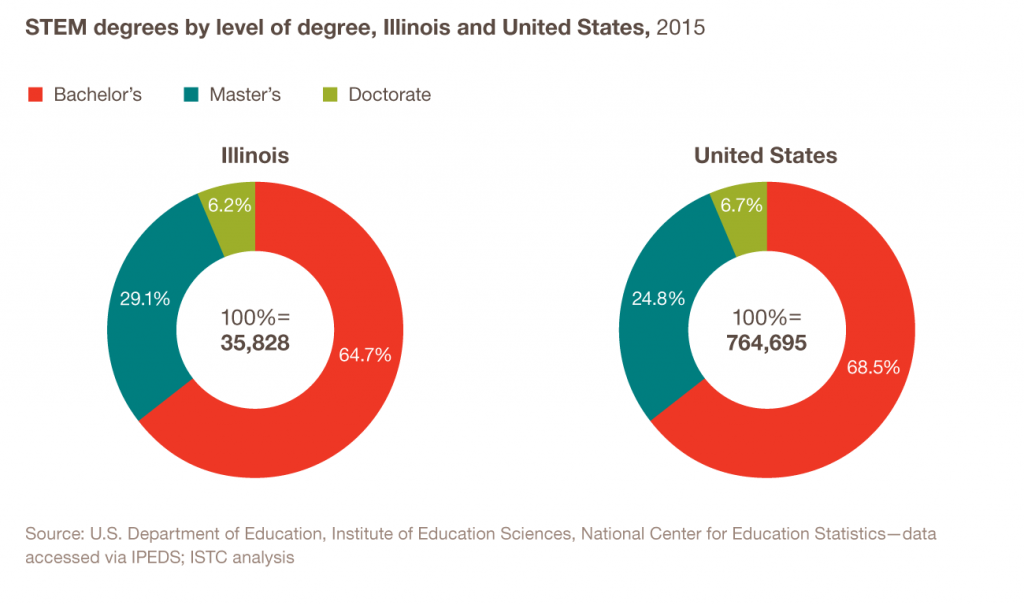
STEM production by field
The concentration of graduates in STEM fields can be influenced by the traditional focus of universities, partnerships between academia and industry, and the emergence of vibrant industries that create the need for STEM graduates over a more sustained period. Illinois’ top STEM fields by number of degrees are health, engineering, and computer sciences. Health degrees exceed the national average by more than seven percentage points, a reflection of Illinois’ robust healthcare sector, while engineering slightly trails the national average.
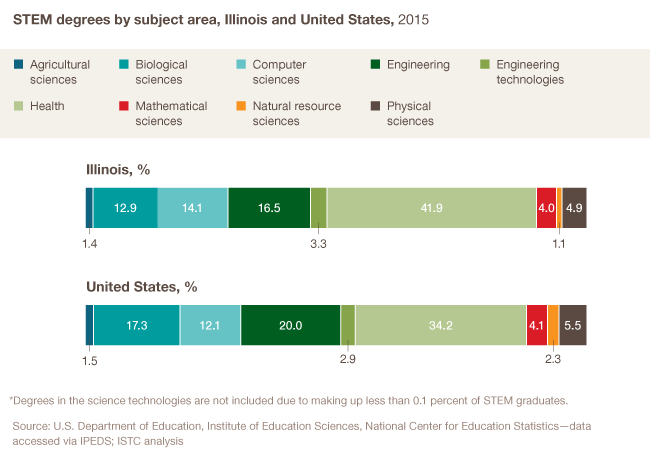
In 2015, Illinois produced nearly 2,500 graduates with computer science degrees, 6 the highest number in over a decade, making Illinois the second-leading producer of computer science degrees in the nation. While 60 percent of all U.S. computer science graduates in 2015 earned a bachelor’s degree, Illinois’ distribution was more heavily tilted to master’s degrees, which accounted for nearly 53 percent of all computer science graduates compared with 36 percent nationally. Illinois’ production of computer science degrees is also growing more quickly than the national average. Graduates in this field in Illinois rose by 23 percent from 2014 to 2015 compared with 18 percent nationally.
Illinois is also a national leader in the production of MBA talent. Although outside the traditional scope of STEM, those with business skills can be extremely valuable when paired with STEM talent, especially in the start-up community. In 2015, Illinois was the fourth-leading producer of MBAs in the United States, with more than 7,000 graduates. Beyond the number of graduates, Illinois boasts the top two graduate business schools in the world 7 The quality and quantity of MBA graduates in Illinois provides in-state STEM talent with a unique advantage when starting a business.
Special feature: Investments in computer science education paying dividends in Illinois
Universities double down on computer science
The growth trend in computer science is likely to continue thanks to investments that state universities have made over the past year. In December 2015, Cleversafe founder Chris Gladwin donated $7.6 million to the Illinois Institute of Technology to increase the scope of computer science at the university. In January 2016, the University of Chicago announced the hiring of prominent data science scholar Michael Franklin as chair of its Department of Computer Science. The announcement outlined the University of Chicago’s intention for “major expansion” of faculty and programs in the department. Continuing the trend, Northwestern University also outlined a plan to invest $150 million in computer science in the coming years, including 20 new hires to support the university’s growth in the field. The University of Illinois at Urbana-Champaign, already the fourth leading producer of computer science degrees in the country, is also taking steps to expand computer science “CS + X Degree Programs”. Other Chicago-area universities with robust computer science programs include DePaul University, Northern Illinois University, and the University of Illinois at Chicago.
Computer science reaching younger students
Computer science education initiatives are also extending beyond the university level with the goal of developing computational thinking skills in younger students. In January 2016, the Obama administration announced a new initiative entitled “Computer Science for All” (or CS4All) that includes $4 billion in funding to states for the expansion of K-12 computer science curriculum, including teacher training and access to high-quality instructional materials. [Megan Smith, “Computer Science For All,” the White House Blog] In Illinois’ largest public school system, Chicago Public Schools (CPS), the CS4All initiative dates back to 2013, when the system announced that computer science would become part of the curriculum in a number of its elementary and high schools. CPS went a step further in February 2016, announcing the addition of computer science as a graduation requirement for high schools, beginning with the 2020 class.

President Obama visits with students learning to code in 2014. Source: Official White House photo
Programs such as CS4All are working to expand computer science education to underrepresented students and to close the gender gap that exists in computer-related fields. These initiatives at the K-12 level, along with investments being made by in-state universities, are helping to grow Illinois’ role as a national leader in computer science talent.
Talent migration
Beyond degree production, another important factor for Illinois’ talent supply is migration. Through location data of member jobs, LinkedIn is able to determine where professionals are moving throughout their careers 8 These data show that Illinois attracts talent from across the Midwest, while losing talent to more populated states such as California and Texas. These data also highlight the skills being gained and lost due to talent migration. Although Illinois is gaining programming skills such as Java, C, and C++, the state is also losing several similar skills such as Perl, Python, and Ruby; cloud computing; and machine learning. These migration patterns, paired with our earlier analysis of computer science degree production in Illinois, show a state that is exporting tech talent to industry hotbeds outside the state.
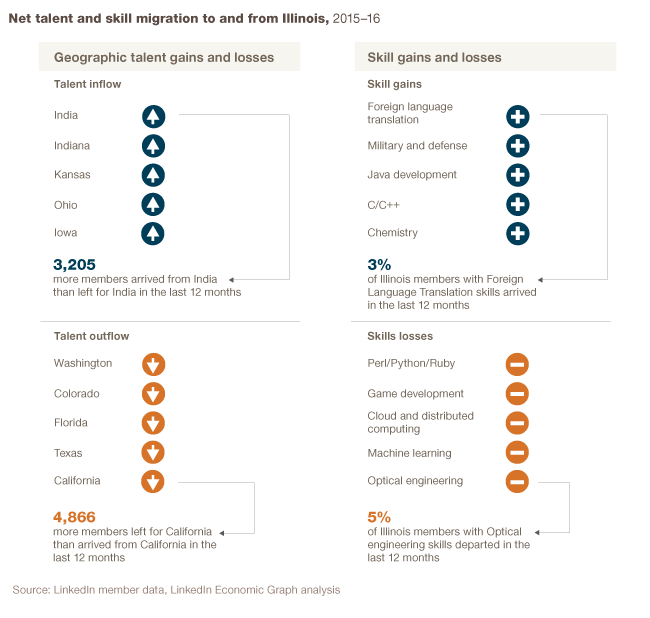
City-level migration data also point to Chicago as a supplier of talent to industry hubs around the country. As the Midwest’s largest economy, Chicago attracts talent from across the region, including Big Ten university towns such as Urbana-Champaign, Illinois; Columbus, Ohio; and Madison, Wisconsin. In turn, Chicago exports talent to growing cities and industry hubs such as Portland, Oregon; Denver, Colorado; and Seattle, Washington. City-level data echo the findings of state migration data, showing Illinois as a magnet for Midwest talent but an exporter of talent nationally.
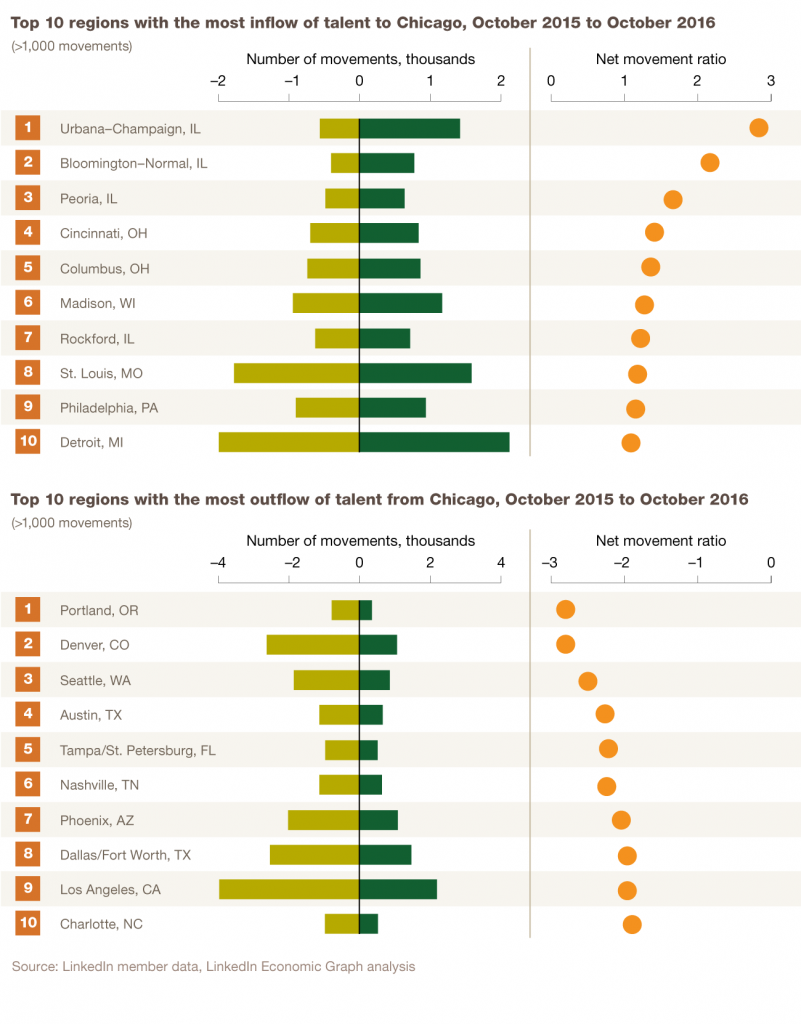
Immigrant talent and workforce are vital to the Illinois economy
Talent migration also extends beyond U.S. borders. For generations, Illinois has welcomed immigrants from all parts of the world into the state economy. Successive waves have helped to build and shape the businesses and institutions that define Illinois. In all, more than 1.7 million Illinois residents were born abroad, the sixth-largest immigrant population in the United States. In 2015, immigrants made up 17.7 percent of the workforce in Illinois, but accounted for 23.1 percent of STEM workers in the state and 22.1 percent of entrepreneurs 9 Illinois ranks above the national average on these measures, making the state and its higher education institutions a destination for students from around the world. In 2015, nearly one-quarter of non-health STEM degrees were awarded to international students (around 5,200 degrees). 10A staggering 68 percent of these degrees were at the master’s level. In fact, the number of non-health STEM master’s degrees awarded to international students has more than doubled since 2007. Overall, Illinois’ concentration of non-health STEM degrees awarded to international students was 48 percent higher than the national average in 2015. These findings continue to illustrate the vital role of international students in Illinois’ STEM talent supply.
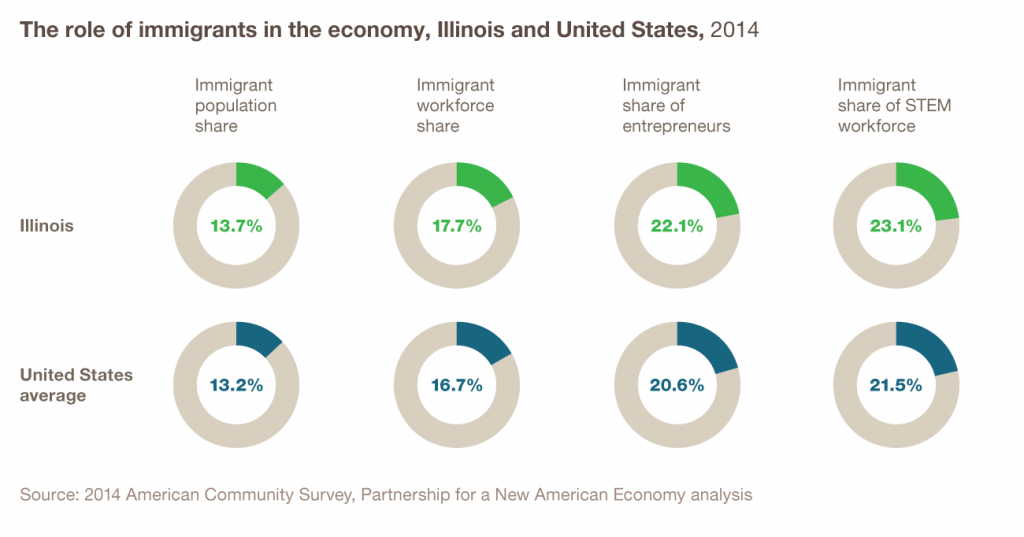
Part II: Demand for STEM talent
This Talent Index’s analysis of demand focuses primarily on the number of Illinois professionals employed in STEM occupations. 11 We looked at current employment for STEM professionals, as well as projected trends for the coming decade. In addition, new data provided by LinkedIn highlight the skills that are in the highest demand among employers.
Current STEM employment in Illinois
For states intent on creating a vibrant STEM ecosystem, a prime challenge is to ensure that STEM graduates at all levels have career opportunities they can pursue without having to relocate. Current data on job openings can provide a snapshot of the market for talent, while longer-term forecasts are vital in matching supply and demand moving forward. Our analysis found that Illinois’ share of STEM occupations is largely in line with the national average, with Illinois trailing by less than half of one percent (4.45 percent compared with 4.85 percent). However, Illinois shows a slight edge in STEM-related occupations over the national average (5.84 percent compared with 5.79 percent). 12 The slightly increased prevalence of STEM-related occupations is due in large part to the size of the healthcare industry in Illinois—more than 95 percent of STEM-related jobs in Illinois (around 340,00 jobs) are in healthcare occupations. In fact, new data from LinkedIn show that occupations in healthcare services in the state exceed the national average by 19 percent.
A look at specific job categories highlights a steady rise in high-demand occupations. From 2012 to 2016, Illinois saw significant growth in computer technology–related fields. In fact, four of Illinois’ top five fastest-growing STEM occupations were related to computer technology, and three recorded double-digit growth during that time. Despite the steady rise in these occupations, each is growing more slowly in Illinois than nationally, suggesting that the state could expand growth in these areas even further.
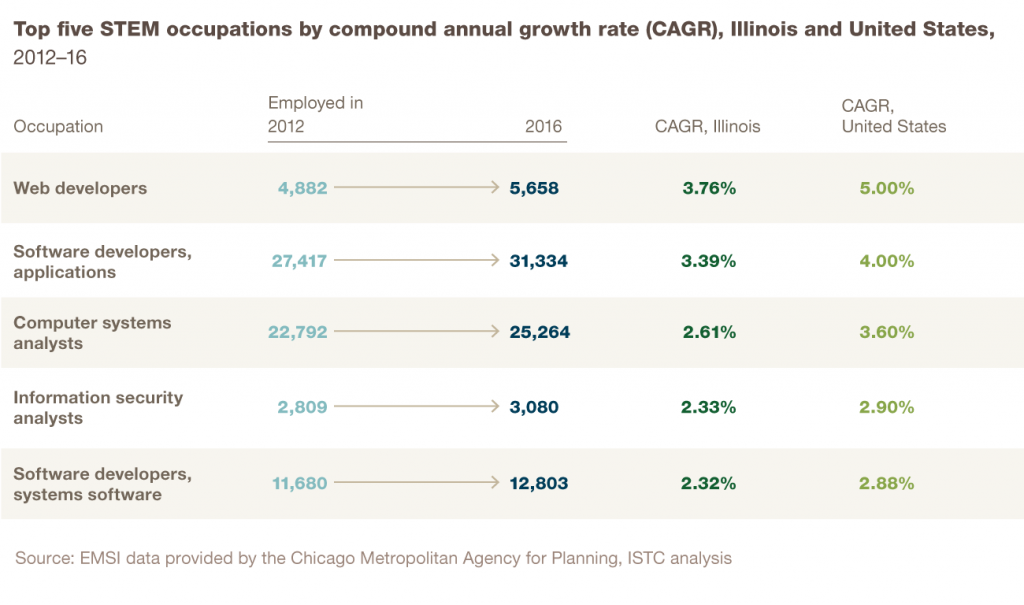
Employment projections for STEM occupations
Illinois is poised to outpace the national average for STEM occupations: over the next decade, STEM jobs in Illinois are forecast to rise 12 percent (compared with an increase of 9 percent for the nation as a whole), bringing the job market more in line with the state’s production of STEM talent. 13 Computer technology–related occupations will lead the way: despite slower than average growth from 2012 to 2016, these jobs are projected to grow more quickly in Illinois than at the national level over the coming decade. Seven of the top 10 fastest-growing occupations in the state are projected to be STEM or STEM-related occupations, while two of the top three—web developers and software developers, applications—are computer technology–related occupations.
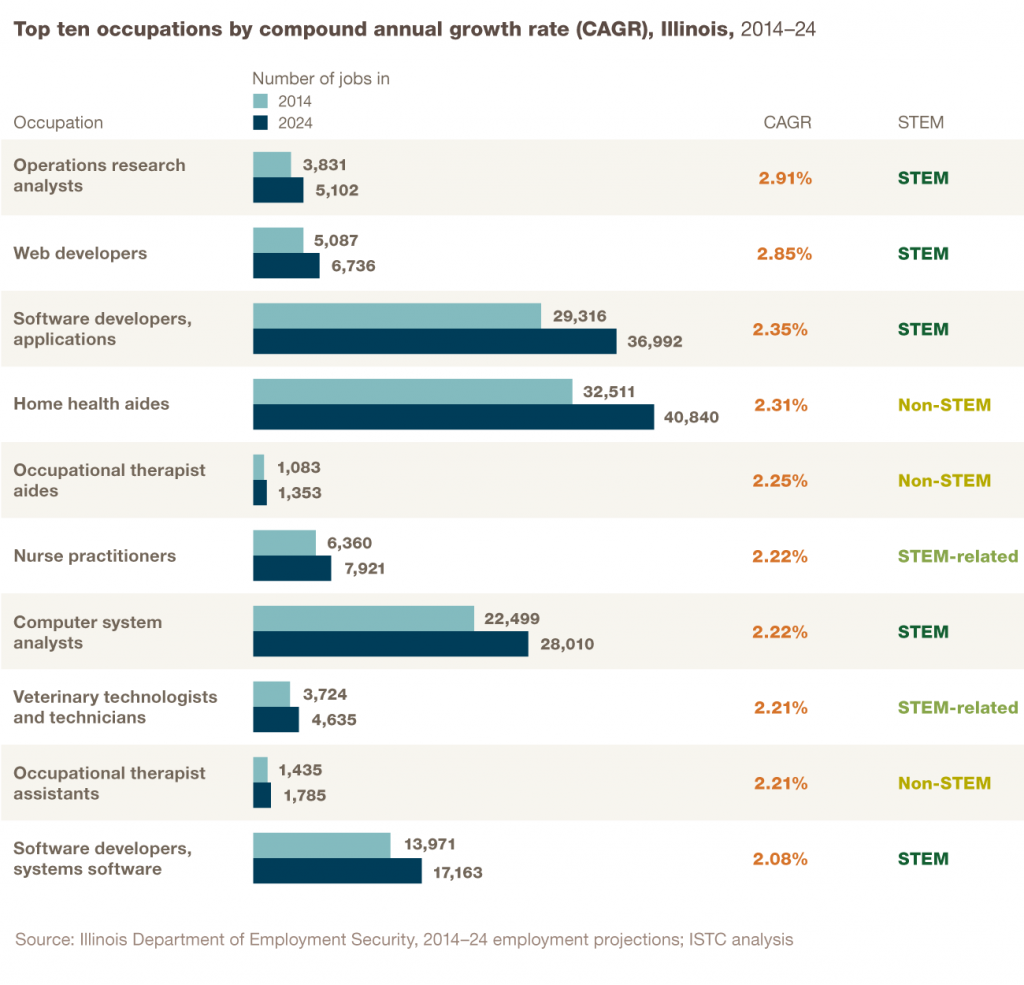
Five of the projected top six fastest-growing STEM occupations in Illinois are computer technology–related occupations, and these jobs are all expected to outpace the national growth average over the coming decade. The accelerated growth of these occupations is likely due to the ever more important role computer science plays regardless of company or industry.
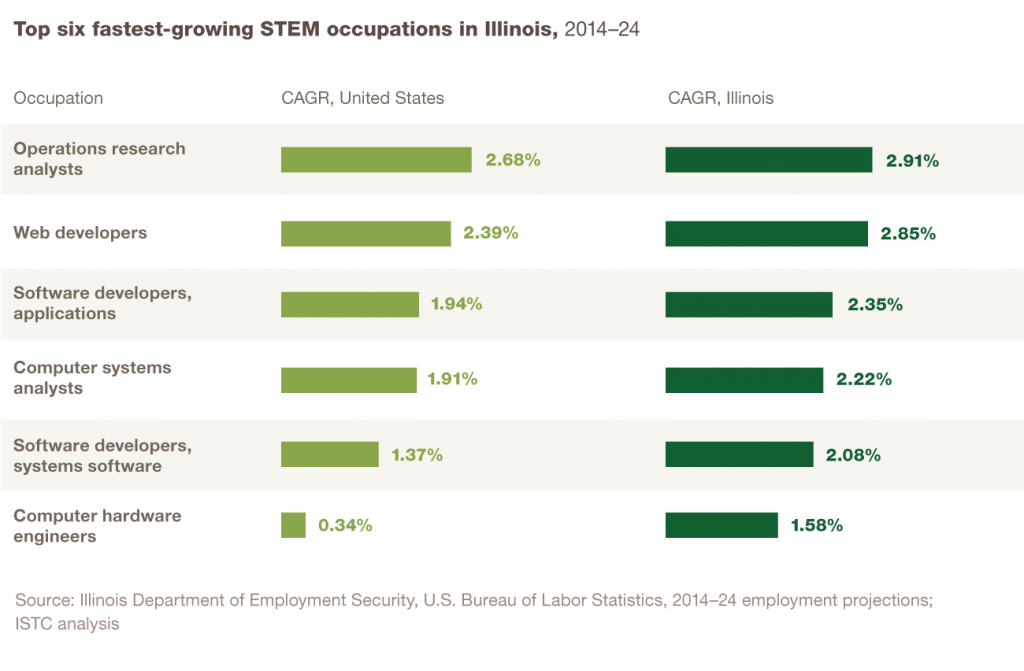
STEM skills in demand
The demand for STEM skills such as programming and computing are expanding beyond typical tech occupations, a trend that has increased the importance of understanding the skills critical to employers. LinkedIn data on these skills provide insight beyond simply the job title of the employee and highlight the importance of several STEM skills.
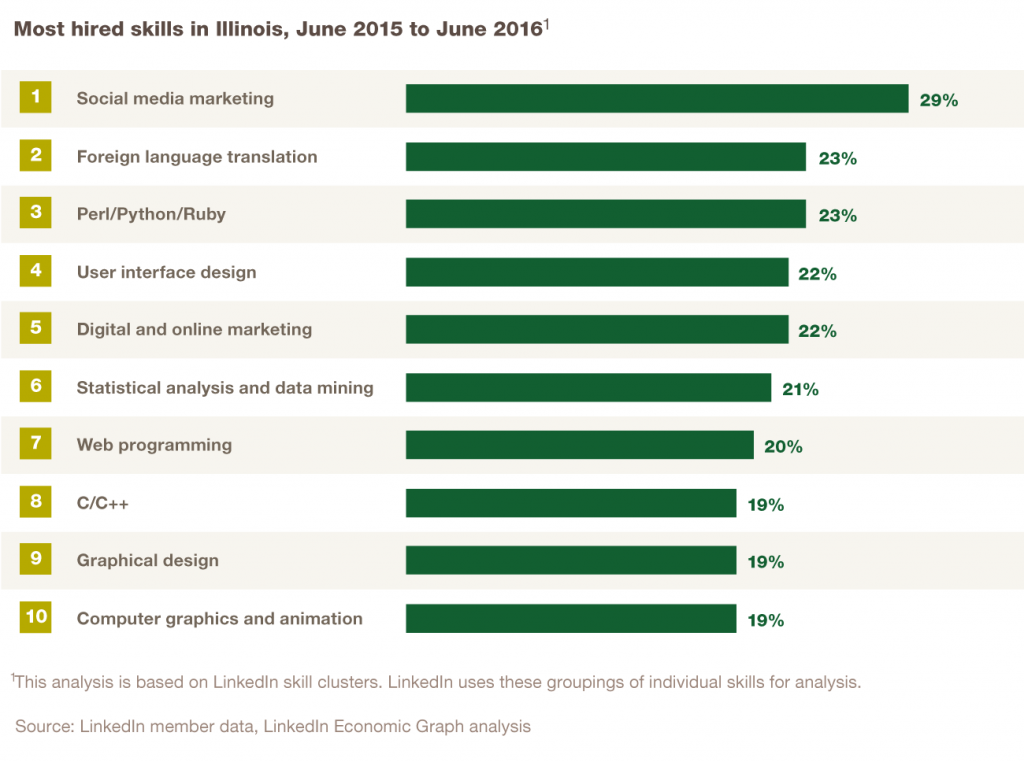
LinkedIn members can choose from more than 50,000 standardized skills to add to their profiles, and LinkedIn clusters skills to define a job title. For example, a journalist’s skills include writing, editing, critical thinking, and communication. These self-reported data allow for a unique look at the skills most sought-after by employers, and the skills most prevalent among a labor force. The top skills hired in Illinois within the past year include a number of STEM skills, such as statistical analysis, computer graphics, and programming languages.
Special feature: LinkedIn’s upcoming Skills Gap Index sheds light on Chicago
For the first time, the Illinois Innovation Index is partnering with LinkedIn to provide a unique perspective on talent supply and demand in the state. LinkedIn is the world’s largest professional network with more than 450 million members worldwide, including 4.2 million members in Illinois. This volume provides the professional network with unique insight into the economy and allows for an analysis of Illinois’ labor force that would otherwise be extremely difficult. Due to be released in early 2017, a new report from LinkedIn will examine the skills gaps in the 50 largest U.S. cities. The skills gap traditionally refers to the difference between supply and demand of professional skills in a city. While the skills gap is often noted, it can be difficult to quantify. LinkedIn’s Skills Gap Index identifies the skills a city’s workforce has and the skills that are most in-demand among the city’s employers and measures the gap between the two [LinkedIn determines supply by noting the prevalence of each skill among its members and demand by noting hiring rates for each skill. Both measures are standardized relative to the 50 U.S. cities studied in the Skills Gap Analysis.]
LinkedIn’s skills gap analysis of Chicago shows the city with a below average skills gap, with slightly more skills in excess than in shortage. Excess skills in Chicago include trading and investing; general finance; telecommunications technology; printing; and management consulting, business strategy, and analysis. These skills represent an opportunity for employers that can more easily find a talented pool of potential employees in Chicago. Conversely, the city also has a shortage n a number of skills, including healthcare management, music production, ecology and environmental science, Microsoft Windows systems, and Web programming. These skill shortages represent an opportunity to attract talent given potential employment opportunities.
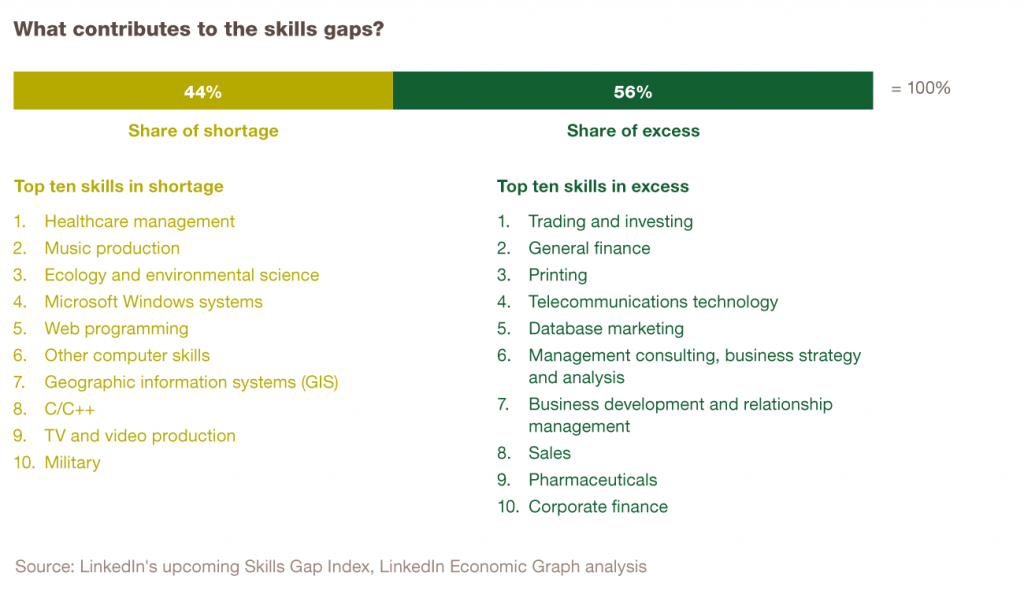
Looking forward
Illinois’ recent growth in STEM degree production, as well as projections of STEM job growth in the coming decade, leave the state well positioned. Despite the positive trajectory, the state should take further steps to capitalize on its STEM talent pipeline. First, the state should look to incorporate STEM talent into industries of strength, including business consulting, trading and investing, and finance. In addition, given the modern STEM workforce is increasingly mobile, the state should work to attract retain STEM talent by expanding linkages to the state’s tech community. These efforts should include building on events such as Illinois Technology Association’s Tech Challenge and World Business Chicago’s Think Chicago, which bring some of the brightest STEM students from across the Midwest to Chicago to compete and learn about opportunities in the state.
As part of the work to attract STEM talent, Illinois must ensure incoming talent has the necessary resources to build and grow businesses in the state. In recent years, Illinois has invested in building communities and workspaces where STEM entrepreneurs can partner with business talent to grow new companies. These efforts include spaces such as 1871, Coalition: Energy, MATTER, mHub, and a network of university-affiliated technology parks, as well as organizations such as Built in Chicago, Clean Energy Trust, and iBIO, among others. Ensuring these spaces and entities have the resources they need to catalyze early-stage companies can provide a significant boost to STEM employment opportunities.
Finally, talent plays a central role in influencing business expansion decisions and attracting employers to the state. In the past year, companies such as Braintree, Capital One, ConAgra, Glassdoor, Horizon Pharma, Vetter Pharma, and Yelp have all announced plans to locate or expand operations in Illinois, driven in part by the supply of skilled talent. In addition, global corporations such as Allstate, Caterpillar, McDonald’s, and Motorola Solutions also plan to increase their presence in the city of Chicago, given its access to tech talent. By highlighting this supply of talent, especially in computer science, business management, and financial services, Illinois can attract employers and give the state’s growing tech economy a competitive advantage.
- Employment Projections: 2014-2024, U.S. Bureau of Labor Statistics ↩
- John I. Jones, “An overview of employment and wages in science, technology, engineering, and math (STEM) groups,” U.S. Bureau of Labor Statistics, April 2014. ↩
- This analysis uses ISTC’s definition of STEM, which remains unchanged from 2015. ↩
- 2015 IPEDS data is preliminary. ↩
- Survey of Graduate Students and Postdoctorates in Science and Engineering, National Science Foundation, 2016. ↩
- Computer science degrees are a subset of the larger Computer Sciences subject area shown in the exhibit above. The Computer Sciences subject area includes other peripheral computer science related degrees beyond the traditional computer science degree highlighted here ↩
- Full-time MBA rankings, Economist, 2016. ↩
- Note that these data include all professionals, not only STEM professionals. ↩
- “The Contributions of New Americans in Illinois,” New American Economy, August 2016. ↩
- We define “international students” as those on a visa specifically reserved for foreign nationals living in the United States for academic study. ↩
- The Index definition of STEM occupations is based on the Standard Occupational Classification system and remains unchanged from 2015. ↩
- Illinois Department of Labor Security and Bureau of Labor Statistics 2014-2024 projections. ↩
- Illinois Department of Employment Security and U.S. Department of Labor Statistics, 2014–24 employment projections. ↩
Archive
2015 – Talent Index
New analysis sheds light on STEM talent supply and demand in Illinois
2014 – Talent Index
Illinois sees continued growth in high-tech businesses and jobs
2014 – Talent Index
STEM attainment in Illinois and talent migration trends in Chicago
2013 – Talent Index
Business climate in Illinois and metropolitan Chicago: Indicators and recent trends
2013 – Talent Index
Talent in Illinois and Chicago: Data and recent trends
